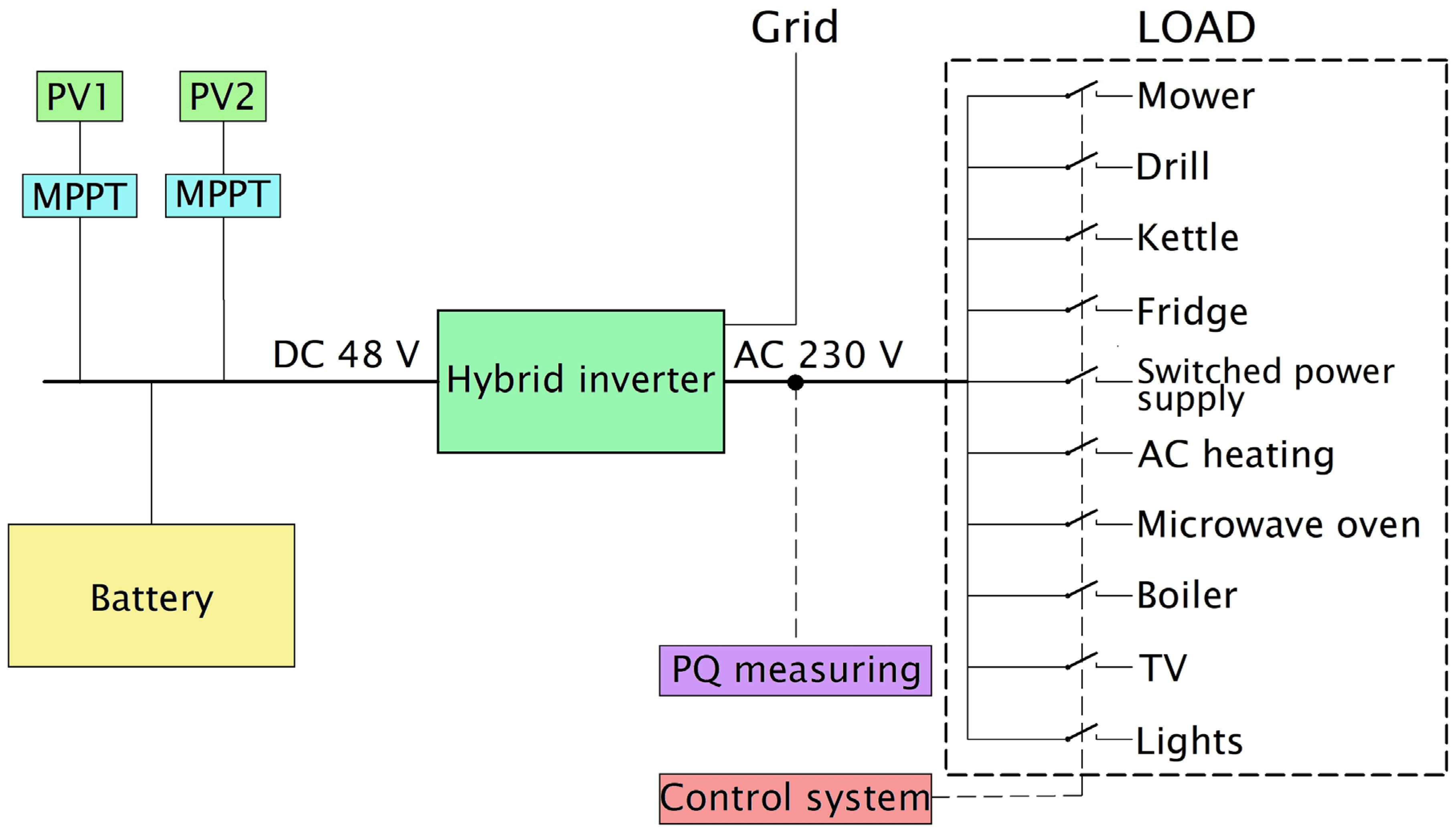An Appliance Impact Estimation on Power Quality Parameters in Microgrid Environment †
Abstract
:1. Introduction
2. Results and Conclusions
Author Contributions
Acknowledgments
Conflicts of Interest
References
- Eckerbert, D.; Larsson-Edefors, P. Interconnect-driven short-circuit power modeling. In Proceedings of the IEEE Euromicro Symposium on Digital Systems Design, Warsaw, Poland, 4–6 September 2001; pp. 414–421. [Google Scholar]
- Saradarzadeh, M.; Farhangi, S.; Schanen, J.L.; Jeannin, P.O.; Frey, D. Combination of power flow controller and short-circuit limiter in distribution electrical network using a cascaded h-bridge distribution-static synchronous series compensator. IET Gener. Transm. Distrib. 2012, 6, 1121–1131. [Google Scholar] [CrossRef]
- Broshi, A. Monitoring power quality beyond en 50160 and iec 61000-4-30. In Proceedings of the IEEE 2007 9th International Conference on Electrical Power Quality and Utilisation, Barcelona, Spain, 9–11 October 2007; pp. 1–6. [Google Scholar]
- Saini, M.K.; Kapoor, R. Classification of power quality events—A review. Int. J. Electr. Power Energy Syst. 2012, 43, 11–19. [Google Scholar] [CrossRef]
- Mahela, O.P.; Shaik, A.G.; Gupta, N. A critical review of detection and classification of power quality events. Renew. Sustain. Energy Rev. 2015, 41, 495–505. [Google Scholar] [CrossRef]
- Biswal, B.; Biswal, M.; Dash, P.K.; Mishra, S. Power quality event characterization using support vector machine and optimization using advanced immune algorithm. Neurocomputing 2013, 103, 75–86. [Google Scholar] [CrossRef]
- De Yong, D.; Bhowmik, S.; Magnago, F. An effective power quality classifier using wavelet transform and support vector machines. Expert Syst. Appl. 2015, 42, 6075–6081. [Google Scholar] [CrossRef]
- Valtierra-Rodriguez, M.; de Jesus Romero-Troncoso, R.; Osornio-Rios, R.A.; Garcia-Perez, A. Detection and classification of single and combined power quality disturbances using neural networks. IEEE Trans. Ind. Electron. 2014, 61, 2473–2482. [Google Scholar] [CrossRef]
- Raptis, T.; Vokas, G.; Langouranis, P.; Kaminaris, S. Total power quality index for electrical networks using neural networks. Energy Procedia 2015, 74, 1499–1507. [Google Scholar] [CrossRef]
- El-Naggar, K.M.; Al-Hasawi, W.M. A genetic based algorithm for measurement of power system disturbances. Electr. Power Syst. Res. 2006, 76, 808–814. [Google Scholar] [CrossRef]
- Nath, S.; Dey, A.; Chakrabarti, A. Detection of power quality disturbances using wavelet transform. World Acad. Sci. Eng. Technol. 2009, 49, 869–873. [Google Scholar]
- Ibrahim, W.R.A.; Morcos, M.M. An adaptive fuzzy self-learning technique for prediction of abnormal operation of electrical systems. IEEE Trans. Power Deliv. 2006, 21, 1770–1777. [Google Scholar] [CrossRef]
- Vantuch, T.; Vidal, A.G.; Ramallo-González, A.P.; Skarmeta, A.F.; Misák, S. Machine learning based electric load forecasting for short and long-term period. In Proceedings of the 2018 IEEE 4th World Forum on Internet of Things (WF-IoT), Singapore, 5–8 February 2018; pp. 511–516. [Google Scholar]

| Appliance | Load (W) | Power Factor (-) | Characteristic | Power Supply | |||||
|---|---|---|---|---|---|---|---|---|---|
| avg | min | max | avg | Inductive | Capacitive | Resistive | Continuous | Switch | |
| Mower | 537.6 | 532.1 | 549.27 | 0.52 | True | False | False | True | False |
| Drill | 157.1 | 149.5 | 167 | 0.49 | True | False | False | True | False |
| Kettle | 619.1 | 617 | 628.3 | 1 | False | False | True | True | True |
| Fridge | 207.6 | 195.5 | 219.5 | 0.72 | True | False | False | True | False |
| Switched mode | 410 | 409.7 | 420.2 | 0.78 | False | True | False | True | True |
| AC heating | 880 | 852.5 | 910 | 0.91 | True | False | False | True | False |
| Microwave | 203 | 76.8 | 1348.3 | 0.84 | True | False | False | False | True |
| Boiler | 307 | 305.8 | 346.5 | 0.99 | False | False | True | True | False |
| TV | 44 | 42.8 | 50.5 | 0.6 | False | True | False | False | True |
| Lights 1 | 156 | 152.5 | 165.1 | 0.84 | False | True | False | False | True |
Publisher’s Note: MDPI stays neutral with regard to jurisdictional claims in published maps and institutional affiliations. |
© 2020 by the authors. Licensee MDPI, Basel, Switzerland. This article is an open access article distributed under the terms and conditions of the Creative Commons Attribution (CC BY) license (https://creativecommons.org/licenses/by/4.0/).
Share and Cite
Blažek, V.; Petružela, M.; Vantuch, T.; Mišák, S.; Slanina, Z.; Walendziuk, W. An Appliance Impact Estimation on Power Quality Parameters in Microgrid Environment. Proceedings 2020, 51, 22. https://doi.org/10.3390/proceedings2020051022
Blažek V, Petružela M, Vantuch T, Mišák S, Slanina Z, Walendziuk W. An Appliance Impact Estimation on Power Quality Parameters in Microgrid Environment. Proceedings. 2020; 51(1):22. https://doi.org/10.3390/proceedings2020051022
Chicago/Turabian StyleBlažek, Vojtěch, Michal Petružela, Tomáš Vantuch, Stanislav Mišák, Zdenek Slanina, and Wojciech Walendziuk. 2020. "An Appliance Impact Estimation on Power Quality Parameters in Microgrid Environment" Proceedings 51, no. 1: 22. https://doi.org/10.3390/proceedings2020051022
APA StyleBlažek, V., Petružela, M., Vantuch, T., Mišák, S., Slanina, Z., & Walendziuk, W. (2020). An Appliance Impact Estimation on Power Quality Parameters in Microgrid Environment. Proceedings, 51(1), 22. https://doi.org/10.3390/proceedings2020051022






